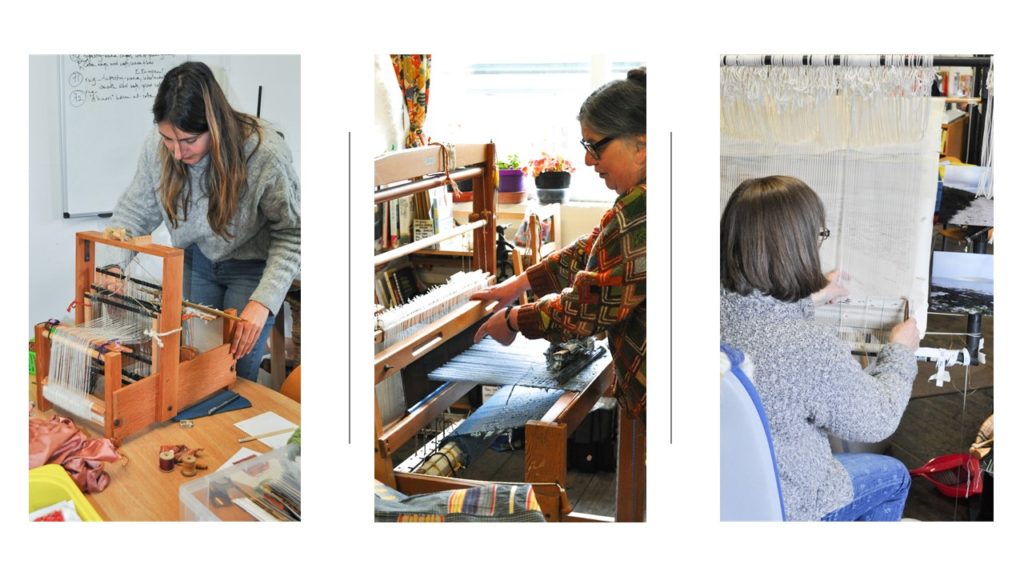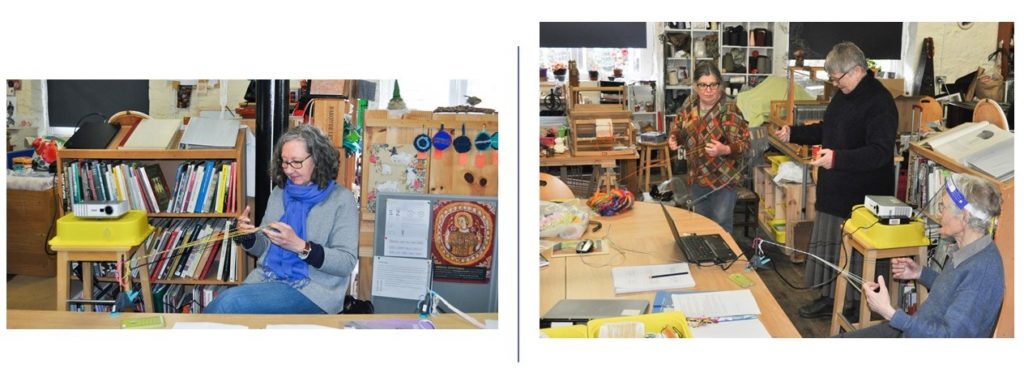
by Sarah Foskett, lecturer, MPhil Textile Conservation.
It felt rather strange to be going somewhere and I was filled with both excitement and slight trepidation as I dusted off my holdall and headed off to Slaithwaite in Yorkshire for the Part 1 of the ETSG Identifying and Describing the Structures of Archaeological and Historic Textiles course. The two-week course, run by tutors Hero-Granger Taylor, textile archaeologist and Ruth Gilbert, weaver and textile historian, aimed to increase participants’ confidence in analysing and recording textile structures, skills that are particularly necessary when examining historic or archaeological textiles which are often fragile and fragmentary. Part 1 had the rather understated title of ‘Simple Weaves’, but in fact covered a wide range of techniques, taking a much broader view of early textiles than the equivalent CIETA course by including, for example, weaving techniques used before heddles such as netting, linking, twining and braiding. This broader approach was one of my motivations for attending, along with wanting to learn more about early and archaeological textiles: how to identify and analyse the techniques present as well as to learn more about the technology that would have produced them. The sessions used an excellent combination of approaches to provide us with a well-rounded understanding of the techniques, only a selection of which there is space to expand upon here.
Diagnosis. Visual analysis was our foremost method of learning on the course and we spent many hours with our necks bent low over a linen glass like fellow participants Raquel and Greta in the image below, taking weave counts, identifying patterns and recording relevant technical information. The number of samples we analysed was huge – from worsted wool herringbones to linen huckabacks and from Ikea bag handles to warp patterned beach bags – and gave us a renewed sense of wonderment at the diversity of structures produced by ‘simple’ weave technology (a term that at times we participants felt was more descriptive of our own capabilities than the textiles!). Alongside useful handouts, bibliographies and links, the samples will also be an immensely valuable resource for the future with each being given a course ‘catalogue’ number and agreed description. Use of internationally agreed terminology is crucial to the accurate describing and recording of information and was a key aspect of the course – my favourite, over which the images below show me puzzling with Hero, was décochement, meaning the number of threads by which each binding is displaced, a particularly important concept when attempting a warp count on a fine silk satin, such as the one under the linen glass.

Demonstrations. Learning through experience is as ancient a concept as some of the textile techniques we were discussing, with Aristotle eruditely promoting the idea as far back as 350 BCE: “for the things we have to learn before we can do them, we learn by doing them”. We were lucky to have both demonstrations and the opportunity for first hand experience of a number of techniques, including weaving with Ruth, braiding and looping with Celia Elliot-Minty and tapestry weaving with Janet Clark. The thought, time and effort that had been put into preparing handouts and samples for us to take away and equipment so that we could ‘have a go’ was really appreciated by all of us, as was the patience of the tutors (thank you Celia and Janet) when it sometimes took a little while for the ‘penny to drop’! These practical sessions added a valuable dimension to our knowledge and understanding – for example, I knew about tablet weaving from having read about it and stared very hard at diagrams depicting the process, but now that I have actually done it, I feel my understanding is have a far more long-lasting and secure. Not only enlightening, all the practical sessions were, of course, also hugely and compellingly enjoyable!


Days out. On the Tuesday of the second week we visited Calderdale Industrial Museum in Halifax, a fascinating museum dedicated to industrial heritage of the area and run almost entirely by volunteers who kindly took time out of their preparations to re-open to the public to give us a detailed and dedicated tour. Covering four floors, the museum houses a very special collection of industrial machinery, including an impressive range of textile machinery, much of which is operational thanks to the expertise and commitment of the volunteers. My group was shown around by Bernard Wadsworth and Roger Depledge, both extremely generous with their knowledge of spinning, weaving, knitting and finishing techniques. I was particularly in awe of the technological ingenuity of the carpet weaving equipment – including a three-quarters Wilton-Brussels carpet loom and a Moquette loom, which is shown below alongside samples of Moquette fabric that had been, coincidently, labelled by Roger as a young salesman. Being able to see the set up of the loom really helped to make sense of the construction of warp pile fabrics and was valuable when we went on to analyse samples of the techniques later in the day.

Prior to the start of the course, two weeks had felt a rather dauntingly long prospect, but 89 samples, 3 practicals, many demonstrations and a good day out later, I was left feeling that I could have done with another 2 weeks! Many thanks to fellow participants Raquel Margalef, Susan Whitfield and Gwendoline ‘Greta’ Pepper with whom it was a great pleasure to spend time and whose own specialist knowledge and perspective certainly enriched the course, to Ruth and Hero for all the planning and organisation (especially during these turbulent and uncertain times) and for sharing their experience with such enthusiasm and to the Anna Plowden Trust for their generosity in supporting my attendance.




Excellent article. Yes it was fun.
What a fascinating course to participate on – such a wealth of knowledge and it sounds extremely hands on, constructing 89 samples! I thoroughly enjoyed reading about your experience and want to book myself on the next course!